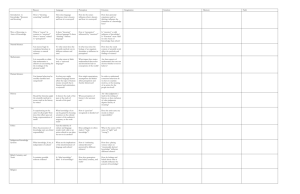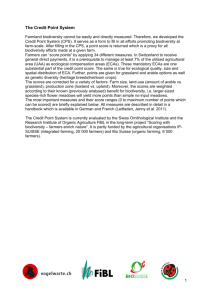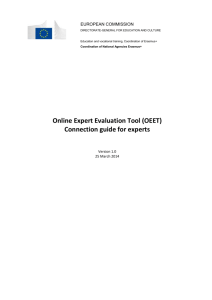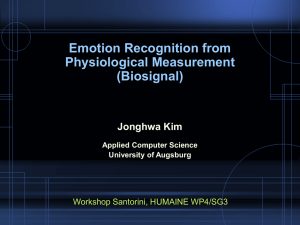overview - AAAC emotion
advertisement
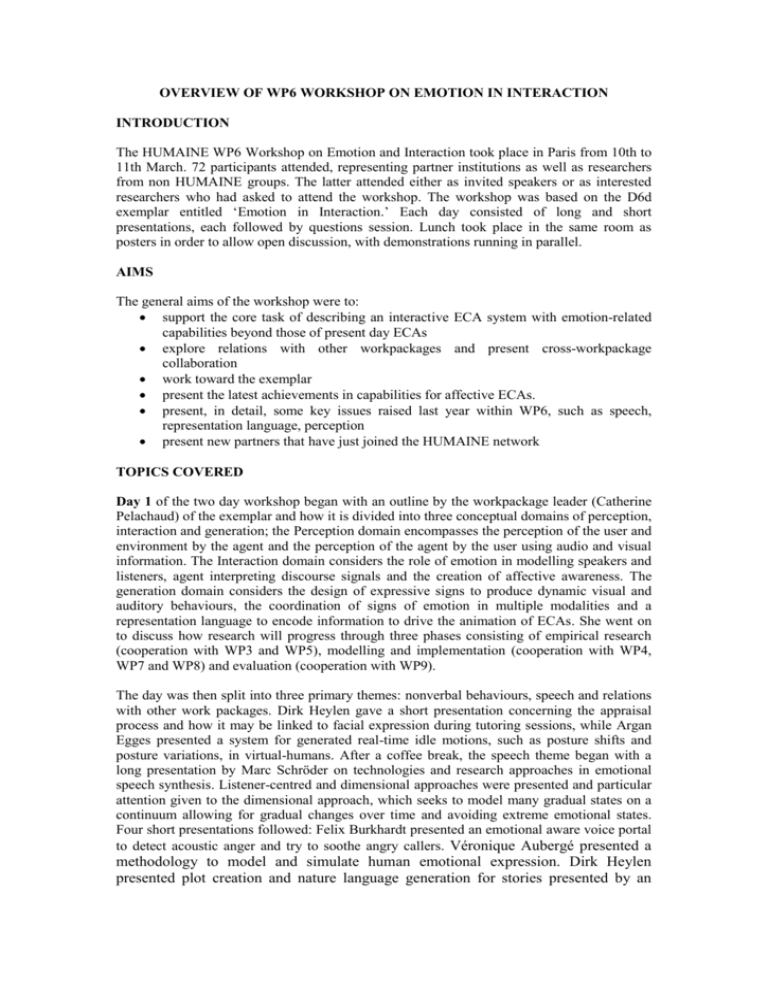
OVERVIEW OF WP6 WORKSHOP ON EMOTION IN INTERACTION INTRODUCTION The HUMAINE WP6 Workshop on Emotion and Interaction took place in Paris from 10th to 11th March. 72 participants attended, representing partner institutions as well as researchers from non HUMAINE groups. The latter attended either as invited speakers or as interested researchers who had asked to attend the workshop. The workshop was based on the D6d exemplar entitled ‘Emotion in Interaction.’ Each day consisted of long and short presentations, each followed by questions session. Lunch took place in the same room as posters in order to allow open discussion, with demonstrations running in parallel. AIMS The general aims of the workshop were to: support the core task of describing an interactive ECA system with emotion-related capabilities beyond those of present day ECAs explore relations with other workpackages and present cross-workpackage collaboration work toward the exemplar present the latest achievements in capabilities for affective ECAs. present, in detail, some key issues raised last year within WP6, such as speech, representation language, perception present new partners that have just joined the HUMAINE network TOPICS COVERED Day 1 of the two day workshop began with an outline by the workpackage leader (Catherine Pelachaud) of the exemplar and how it is divided into three conceptual domains of perception, interaction and generation; the Perception domain encompasses the perception of the user and environment by the agent and the perception of the agent by the user using audio and visual information. The Interaction domain considers the role of emotion in modelling speakers and listeners, agent interpreting discourse signals and the creation of affective awareness. The generation domain considers the design of expressive signs to produce dynamic visual and auditory behaviours, the coordination of signs of emotion in multiple modalities and a representation language to encode information to drive the animation of ECAs. She went on to discuss how research will progress through three phases consisting of empirical research (cooperation with WP3 and WP5), modelling and implementation (cooperation with WP4, WP7 and WP8) and evaluation (cooperation with WP9). The day was then split into three primary themes: nonverbal behaviours, speech and relations with other work packages. Dirk Heylen gave a short presentation concerning the appraisal process and how it may be linked to facial expression during tutoring sessions, while Argan Egges presented a system for generated real-time idle motions, such as posture shifts and posture variations, in virtual-humans. After a coffee break, the speech theme began with a long presentation by Marc Schröder on technologies and research approaches in emotional speech synthesis. Listener-centred and dimensional approaches were presented and particular attention given to the dimensional approach, which seeks to model many gradual states on a continuum allowing for gradual changes over time and avoiding extreme emotional states. Four short presentations followed: Felix Burkhardt presented an emotional aware voice portal to detect acoustic anger and try to soothe angry callers. Véronique Aubergé presented a methodology to model and simulate human emotional expression. Dirk Heylen presented plot creation and nature language generation for stories presented by an embodied speaking agent, with prosody used to express suspense. Béatrice Cahour presented a method for evaluating subtle user emotions during interactive situations. Between the morning and the afternoon sessions there was a long break, allowing for lunch, lengthy discussions and the poster session, which was displayed in the same room as lunch was served. Demos took place in parallel and the relaxed atmosphere allowed all partners to mingle and have lengthy discussions concerning their research interests in the HUMAINE network. In the afternoon, the theme was focused on research taking place across workpackages and involving WP6. In relation to WP3 Mei Yii Lim presented an emergent model of emotion for agents based on the PSI model of emotion. For WP4, Ginevra Castellan presented expressive gesture in interaction and evaluation of the role of movement and gesture in emotion through motor activation using music as an induction technique. For WP5, Roeland Ordelman and Dirk Heylen presented an annotation of emotions for meetings using FeelTrace. In relation to WP7, Christopher Peters presented a model of theory of mind for agents in a virtual environment. Marco Guerini and Elisabetta Bevacqua considered ethical issues for persuasive interfaces and persuasive listeners in conversation. The session concluded with a talk by Addolorata Cavalluzzi on the use of Wizard of Oz studies in the iterative design of ECAs in relation to WP9. Day 2 focused on the role of emotion in interaction and its possible representation. It started with a long presentation by Christopher Peters which considered how ECAs could be endowed with perception abilities for the purposes of making inferences based on the directions in which another was attending. The session continued with several short presentations studying socially intelligent agents, empathy in affective interactions and gaze behaviours in multi-party ECA interactions. After a coffee break, there were short presentations by Peter Wallis and Yorick Wilks regarding the role of interaction and emotion in the creation of companions and by Arnaud Blanchard on the relationship between synchronisation and affective bonds for the study of emotional contagion using robots. Brigette Krenn conducted a long presentation on representation languages, a key issue in WP6; the concept of emotional lego was central to the talk. This outlined the use of flexible, reusable, extendable bits and pieces of representations containing ECA-relevant information. This was followed by short a presentation on affectemic analysis by Lesley Axelrod and Kate Hone from Brunel University which considered the evaluation of user interaction with affective systems. The rest of the day consisted of lab presentations of new Humaine members by the University of Sheffield, the University of Twente and CNRS/University of Paris and University Cergy Pontoise. Details of groups, research projects, research interests and new HUMAINE researchers were provided so as to facilitate their integration within the HUMAINE network and raise awareness of research relevant to HUMAINE for the purposes of possible collaborations. DISCUSSION AND OUTCOMES There were discussions after lunch and at the end of each day. A concluding session summarised the issues of importance to the workshop and future collaboration. Issues debated were: The type of data needed for work on gestures and ECAs Representation or representations of emotions Necessary capabilities for ECAs Necessity of working on correlary aspects of emotions to be able to create affective interactive ECAs

